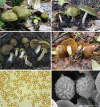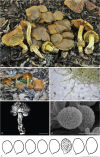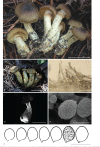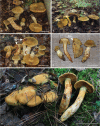Cortinarius subgenus Leprocybe in Europe: expanded Sanger and Next Generation Sequencing unveil unexpected diversity in the Mediterranean
- PMID: 35935890
- PMCID: PMC9311388
- DOI: 10.3767/persoonia.2021.46.07
Cortinarius subgenus Leprocybe in Europe: expanded Sanger and Next Generation Sequencing unveil unexpected diversity in the Mediterranean
Abstract
Molecular phylogenies in the past decade have demonstrated that the described diversity of Cortinarius is still underestimated, especially outside continental and boreal ecoregions where the genus has been historically investigated. We tackled this issue by revisiting the so far unresolved subgenus Leprocybe, and focused on the largely unexplored Mediterranean hotspot of biodiversity. The sequencing and phylogenetic analysis of 161 vouchered collections from Austria, Cyprus, France, Germany, Italy and Spain, including 16 types, allowed for the delineation of 11 species in this lineage, three of them recognised as new to science and formally introduced as C. jimenezianus, C. selinolens and C. viridans spp. nov., respectively. Interestingly, the newly described species exhibit a strict Mediterranean distribution, and one of them is putatively endemic to the island of Cyprus, highlighting the remarkable potential of this neglected ecoregion to uncover further undescribed diversity of Cortinarius in the future. The present work also unveils 23 synonymies in this subgenus, as well as previously undetected crypticism within C. venetus. Next Generation Sequencing carried out on three old and contaminated holotypes, successfully decrypts their phylogenetic identity, including that of C. leproleptopus, finally settling the long-standing controversy over the taxonomic status of this species. A brief overview of each species in the subgenus is lastly provided and a key is proposed to facilitate the identification of presently known European taxa of Leprocybe in the field. Citation: Bidaud A, Loizides M, Armada F, et al. 2021. Cortinarius subgenus Leprocybe in Europe: expanded Sanger and Next Generation Sequencing unveil unexpected diversity in the Mediterranean. Persoonia 46: 188-215. https://doi.org/10.3767/persoonia.2021.46.07.
Keywords: Cedrus brevifolia; Veneti; endemism; phylogeny; taxonomy.
© 2021 Naturalis Biodiversity Center & Westerdijk Fungal Biodiversity Institute.
Figures










References
-
- Ágreda T, Águeda B, Olano JM, et al. . 2015. Increased evapotranspiration demand in a Mediterranean climate might cause a decline in fungal yields under global warming. Global Change Biology 21 (9): 3499–3510. - PubMed
-
- Ammirati J, Barlow TE, Seidl M, et al. . 2012. Cortinarius parkeri, a new species from the Pacific Northwest of North America. Botany 90: 327–335.
-
- Ballarà J, Mahiques R, Garrido-Benavent I. 2017. Estudi de Cortinariaceae del Parc natural Cadí-Moixeró (IV). Moixeró 9: 20–49.
LinkOut - more resources
Full Text Sources
Miscellaneous
